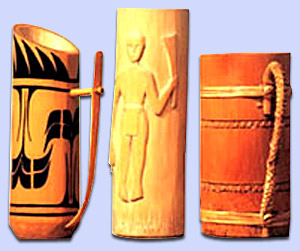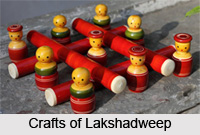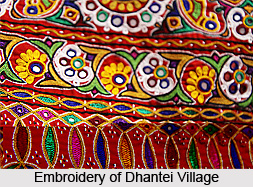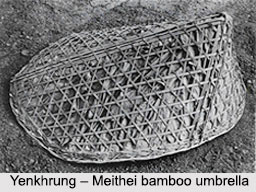 North Eastern India, including Manipur, is a region known for heavy rainfall. But during the sunny days, the region also experiences scorching sun. Therefore, in any case the impact of climate and weather is intolerable unless protection is taken, cheapest being the umbrellas. Umbrellas, in Manipur, are also considered as a status symbol of princes and nobles, but had come to far common use even during the period of feudal administration.
North Eastern India, including Manipur, is a region known for heavy rainfall. But during the sunny days, the region also experiences scorching sun. Therefore, in any case the impact of climate and weather is intolerable unless protection is taken, cheapest being the umbrellas. Umbrellas, in Manipur, are also considered as a status symbol of princes and nobles, but had come to far common use even during the period of feudal administration.
Scholar T. C. Hodson in his book, "The Meitheis", observed: "Plates, bottle of material and cheap earthen wave are found in many houses, for the withdrawal of the numerous sumptuary and economic restrictions which formed so conspicuous a part of the political system of a former day, has undoubtedly been the cause of a rise in the general taste of the community, so that articles, such as an umbrella, once the treasured token of royalty, or at least of royal favour, are now carried without fear of let or hindrance."
Thus, umbrellas came to stay as common article of use by the people of Manipur, till during the recent years when modern waterproof garments have been introduced. Traditionally, umbrellas used were made of cane and bamboo and later modern umbrella with cane or metal handle with cloth top was introduced, being either brought from Calcutta or smuggled across the border.
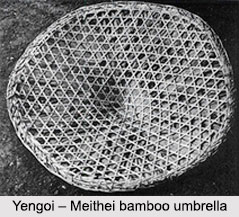 People in the rural areas use 3 types of bamboo umbrella, referred to as Yenpak, worn or borne on the head, to shield from the heat and rain while going to work and even when working in the paddy fields. The types of Yenpak used are Yenkhrung, Salaitep and Yengoi. People venturing out to fish on the Loktak Lake wear on their heads a smaller version of the Yengoi umbrella. When working in the paddy fields, the use of Yenkhrung umbrella safeguards the upper part of the body from direct heat as well as from getting wet when it rains. As such, the Yenkhrung umbrella is commonly used by the rural populace living in the plains as well as by those inhabiting the hill slopes. The Yenkhrung measures 95 centimetres in length, 81 centimetres in breadth and stretches 40 centimetres high.
People in the rural areas use 3 types of bamboo umbrella, referred to as Yenpak, worn or borne on the head, to shield from the heat and rain while going to work and even when working in the paddy fields. The types of Yenpak used are Yenkhrung, Salaitep and Yengoi. People venturing out to fish on the Loktak Lake wear on their heads a smaller version of the Yengoi umbrella. When working in the paddy fields, the use of Yenkhrung umbrella safeguards the upper part of the body from direct heat as well as from getting wet when it rains. As such, the Yenkhrung umbrella is commonly used by the rural populace living in the plains as well as by those inhabiting the hill slopes. The Yenkhrung measures 95 centimetres in length, 81 centimetres in breadth and stretches 40 centimetres high.
For some villages in the eastern part of Manipur, the use of Yenkhrung umbrella is prohibited even today. This is based on a rural folklore of the region that had been handed down the ages, which has got something to do with this particular type of Yenpak. The Salaitep umbrella is practically out of use. At times, whilst carrying conical baskets laden with goods, this particular umbrella is used to ward off the rains and keep the goods and the body dry and safe. The women vendors sitting in unsheltered places use the big Yengoi umbrellas perched on bamboo poles, to ward off the heat and the rains.
The Gouriya Vaishnavites of Manipur use small Yengoi umbrella at the time of a person`s death and the Shraadha ceremony of the deceased person. This is practised for the people who have been adorned with the sacred thread. The Yengoi bamboo umbrellas usually have a diameter around 93 centimetres.
The Yenpak, made with the primary objective of warding off heat and rain, has a pattern of weaving conforming to diagonals filled in the texture of open hexagonal weave. It has a double weave, with an intermediary layer of very light and dry Leihoura leaves, which makes the Yenpak waterproof. Some people use Waarukak (a sheath of culm) as the intermediary layer in place of Leihoura leaves. But it is rarely used since it tends to make the Yenpak heavier. Yenpaks with the intermediary layer of Waarukak are often used for death ceremonies such as Shraadha. People in the hills use broad, crisp leaves (of trees such as teak) for the intermediary layer in the Yenpak. After completing the inner and the outer weaves, and after inserting the desired intermediary layer, the rim of the Yenpak is bound tightly with cane splits to secure it firmly.
Related Articles:
Cane and Bamboo Products of Manipur
Manipur
Meithei Language
Crafts of Manipur
Bamboo and Cane Crafts of Manipur
Bamboo Crafts in India
Weaving and Dyeing Craft
Cane Craft



